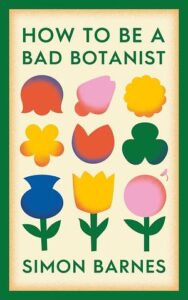
Type : Nonfiction
Genres : Nature, Informative
Pays : UK
Auteur : Simon Barnes
Illustrations : Cindy Lee Wright
Publication : 2024
Lecture : du 2025/05/23 au 2025/06/24
Can you tell a tomato from a grape? A patch of grass from a Christmas tree? Then congratulations – you’re a botanist.
Self-confessed bad birdwatcher Simon Barnes thought he knew nothing about plants. He didn’t have anything against them: trees are interesting because birds perch in them; plants are useful because they create habitats, and all birds live in habitats. But while admiring the tenacity of some yellow horned poppies thriving on a shingle beach – a place where it seemed no plant had a hope of surviving – he was struck by a simple yet profound truth. It all begins with plants.
In this charming and inspiring book, Barnes takes us on a fascinating journey, from the simple genius of photosynthesis to the complex and bizarre ways that plants reproduce. We consider plants as varied as cabbages and conifers, familiar wildflowers and enigmatic orchids, nefarious parasites and plants that carry deadly poisons – helping us better appreciate the beauty and diversity of the natural world.
Both a primer on botany and an exploration of how plants make our external and interior worlds, How to Be a Bad Botanist opens our eyes to the wonders around us. Plants are everywhere, in every part of your life, and you know more than you think.
Il m’a pris du temps à lire (outre la coupure de plusieurs semaines) parce qu’il me fallait souvent traduire le nom des plantes et que du coup derrière j’en lisais un peu plus dessus. Et au final oui , je suis aussi un mauvais botaniste qui en sait plus que ce qu’il pense, mais il me faut le bon terme quand même, surtout quand Cow Parsley (littéralement persil de vache) est par chez nous du Cerfeuil sauvage. Y’a de quoi porter à confusion même si d’autres sont ok avec des traduction littérales.
Sinon à part ça il est intéressant à lire (même si forcément c’est plus focalisé sur la flore anglaise) parce qu’on apprend pas mal de choses, on redécouvre des choses que l’on sait, et l’auteur distille le tout avec ses propres expériences et autres, et franchement c’était bien.
J’avoue, la partie la plus fascinante pour moi a été le chapitre 23 avec le passage sur les plantes toxiques. Les classiques Ciguë et Digitale, on connait, mais le Giant Hogweed / Berce du Caucase, je ne connaissais pas et je n’ai pas du tout envie de toucher quand je vois ce que ça fait o0
Par contre ça me donne envie de lire The Forensics of Agatha Christie.
#Lectures 2025 #Simon Barnes